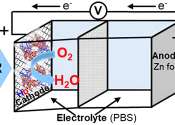Bio-FlatScope dives deep for useful data
Want to monitor the brain of a running tiger?
Mar 7, 2022
0
128
Engineering

Want to monitor the brain of a running tiger?
Mar 7, 2022
0
128
Engineering

Engineers at the University of California San Diego have developed a smartphone case and app that could make it easier for patients to record and track their blood glucose readings, whether they're at home or on the go.
Dec 7, 2017
0
4593
Machine learning & AI

Machine learning tools selected three biomarkers—lactic dehydrogenase, lymphocyte and high-sensitivity C-reactive protein levels—that can predict the mortality of COVID-19 patients from blood samples from 485 infected ...
May 15, 2020
0
9
Energy & Green Tech

A team with the Chemical Institute for Energy and the Environment (IQUEMA) at the University of Cordoba has come up with a battery that uses hemoglobin as an electrochemical reaction facilitator, functioning for around 20–30 ...
Jan 9, 2024
0
46
Engineering

Engineers at the University of California San Diego have developed a miniature, ultra-low power injectable biosensor that could be used for continuous, long-term alcohol monitoring. The chip is small enough to be implanted ...
Apr 10, 2018
0
309
Hi Tech & Innovation

A "needle-free blood draw" is the title of a patent that was filed in May 2014 by Google and was made known earlier this month.
Engineering

Newly developed flexible, porous and highly sensitive nitrogen dioxide sensors that can be applied to skin and clothing have potential applications in health care, environmental health monitoring and military use, according ...
May 20, 2022
0
128
Automotive

Breath-sniffing sensors and finger-scanning detectors are central to a landmark US safety mandate to fight drunk driving that is spurring tough questions about what technology can be trusted to do.
Nov 18, 2021
0
43
Hi Tech & Innovation

Counting calories or how many steps you will need to take to work off a wedding feast are not the only features of fitness monitoring. Patients today may be asked to check their blood pressure at home and will be interested ...
Electronics & Semiconductors

A new approach to tackling the spread of malaria in sub-Saharan Africa, which combines affordable, easy-to-administer blood tests with machine learning and unbreakable encryption, has generated encouraging early results in ...
Aug 3, 2021
0
126
Blood is a specialized bodily fluid that delivers necessary substances to the body's cells — such as nutrients and oxygen — and transports waste products away from those same cells.
In vertebrates, it is composed of blood cells suspended in a liquid called blood plasma. Plasma, which comprises 55% of blood fluid, is mostly water (90% by volume), and contains dissolved proteins, glucose, mineral ions, hormones, carbon dioxide (plasma being the main medium for excretory product transportation), platelets and blood cells themselves. The blood cells present in blood are mainly red blood cells (also called RBCs or erythrocytes) and white blood cells, including leukocytes and platelets. The most abundant cells in vertebrate blood are red blood cells. These contain hemoglobin, an iron-containing protein, which facilitates transportation of oxygen by reversibly binding to this respiratory gas and greatly increasing its solubility in blood. In contrast, carbon dioxide is almost entirely transported extracellularly dissolved in plasma as bicarbonate ion.
Vertebrate blood is bright-red when its hemoglobin is oxygenated. Some animals, such as crustaceans and mollusks, use hemocyanin to carry oxygen, instead of hemoglobin. Insects and some molluscs use a fluid called hemolymph instead of blood, the difference being that hemolymph is not contained in a closed circulatory system. In most insects, this "blood" does not contain oxygen-carrying molecules such as hemoglobin because their bodies are small enough for their tracheal system to suffice for supplying oxygen.
Jawed vertebrates have an adaptive immune system, based largely on white blood cells. White blood cells help to resist infections and parasites. Platelets are important in the clotting of blood. Arthropods, using hemolymph, have hemocytes as part of their immune system.
Blood is circulated around the body through blood vessels by the pumping action of the heart. In animals having lungs, arterial blood carries oxygen from inhaled air to the tissues of the body, and venous blood carries carbon dioxide, a waste product of metabolism produced by cells, from the tissues to the lungs to be exhaled.
Medical terms related to blood often begin with hemo- or hemato- (also spelled haemo- and haemato-) from the Ancient Greek word αἶμα (haima) for "blood". In terms of anatomy and histology, blood is considered a specialized form of connective tissue, given its origin in the bones and the presence of potential molecular fibers in the form of fibrinogen.
This text uses material from Wikipedia, licensed under CC BY-SA